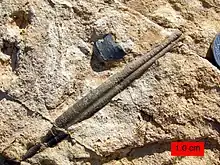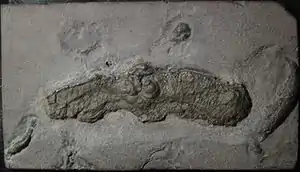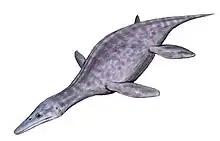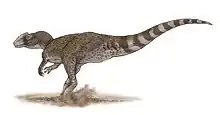Callovian
In the geologic timescale, the Callovian is an age and stage in the Middle Jurassic, lasting between 166.1 ± 4.0 Ma (million years ago) and 163.5 ± 4.0 Ma. It is the last stage of the Middle Jurassic, following the Bathonian and preceding the Oxfordian.[1]
| Callovian | |
|---|---|
| 166.1 ± 1.2 – 163.5 ± 1.0 Ma | |
| Chronology | |
Key events in the Jurassic -200 — – -195 — – -190 — – -185 — – -180 — – -175 — – -170 — – -165 — – -160 — – -155 — – -150 — – -145 — – how to approximate the timescale of key Jurassic events. Vertical axis: millions of years ago. | |
| Etymology | |
| Name formality | Formal |
| Usage information | |
| Celestial body | Earth |
| Regional usage | Global (ICS) |
| Time scale(s) used | ICS Time Scale |
| Definition | |
| Chronological unit | Age |
| Stratigraphic unit | Stage |
| Time span formality | Formal |
| Lower boundary definition | Not formally defined |
| Lower boundary definition candidates | FAD of the Ammonite genus Kepplerites |
| Lower boundary GSSP candidate section(s) | |
| Upper boundary definition | Not formally defined |
| Upper boundary definition candidates | Horizon of Ammonite Cardioceras redcliffense. |
| Upper boundary GSSP candidate section(s) |
|
Stratigraphic definitions
The Callovian stage was first described by French palaeontologist Alcide d'Orbigny in 1852. Its name derives from the latinized name for Kellaways Bridge, a small hamlet 3 km north-east of Chippenham, Wiltshire, England.
The base of the Callovian is defined as the place in the stratigraphic column where the ammonite genus Kepplerites first appears, which is the base of the biozone of Macrocephalites herveyi. A global reference profile (a GSSP) for the base had in 2009 not yet been assigned.
The top of the Callovian (the base of the Oxfordian) is at the first appearance of ammonite species Brightia thuouxensis.
Subdivision

The Callovian is often subdivided into three substages (or subages): Lower/Early, Middle and Upper/Late Callovian. In the Tethys domain, the Callovian encompasses six ammonite biozones:
- zone of Quenstedtoceras lamberti
- zone of Peltoceras athleta
- zone of Erymnoceras coronatum
- zone of Reineckeia anceps
- zone of Macrocephalites gracilis
- zone of Bullatimorphites bullatus
Palaeogeography

During the Callovian, Europe was an archipelago of a dozen or so large islands. Between them were extensive areas of continental shelf. Consequently, there are shallow marine Callovian deposits in Russia and from Belarus, through Poland and Germany, into France and eastern Spain and much of England. Around the former island coasts are frequently, land-derived sediments. These are to be found, for example, in western Scotland.[3]
The Louann Salt and the southern Campeche Salt of the Gulf of Mexico are thought to have formed by an embayment of the Pacific Ocean across modern-day Mexico.[4]
Palaeontology
Amphibians
| Amphibians of the Oxfordian | ||||
|---|---|---|---|---|
| Taxa | Presence | Location | Description | Images |
| China; Mongolia; Russia | Gobiops desertus was a brachyopid temnospondyl. | |||
Ankylosaurians
| Ankylosauria of the Callovian | ||||
|---|---|---|---|---|
| Taxa | Presence | Location | Description | Images |
|
a basal ankylosaurian known from a partial mandible |
||||
Crocodylomorphs
| Crocodylomorphs of the Callovian | ||||
|---|---|---|---|---|
| Taxa | Presence | Location | Description | Images |
Charitomenosuchus
|
Callovian | Oxford Clay Formation of England | A machimosaurid thalattosuchian. |  Life restoration of a Thalattosuchus superciliosus. |
Gracilineustes
|
Callovian to Kimmeridgian | Spain | A small metriorhynchid thalattosuchian in the subfamily Metriorhynchinae. | |
Ieldraan
|
Callovian to Kimmeridgian | Oxford Clay Formation of England | A metriorhynchid thalattosuchian in the subfamily Geosaurinae. | |
Junggarsuchus
|
Callovian | China | The sphenosuchian Junggarsuchus was a small, ~1 meter long, predator. | |
Lemmysuchus
|
Callovian | Oxford Clay Formation of England, and France | A machimosaurid thalattosuchian in the tribe Machimosaurini. | |
Maledictosuchus
|
Callovian to Kimmeridgian | Spain | A small metriorhynchid thalattosuchian in the subfamily Metriorhynchinae. | |
Mycterosuchus
|
Callovian | Oxford Clay Formation of England | A teleosaurid thalattosuchian in the subfamily Aeolodontinae. | |
Neosteneosaurus
|
Callovian | Oxford Clay Formation of England, and France | A machimosaurid thalattosuchian in the subfamily Machimosaurinae. | |
Proexochokefalos
|
Callovian to Kimmeridgian | Oxford Clay Formation of England, and France | A machimosaurid thalattosuchian in the subfamily Machimosaurinae. | |
Steneosaurus
|
late Callovian or early Oxfordian | France | A dubious taxon of teleosauroid thalattosuchian. The genus has been used as a wastebasket taxon for thalattosuchian fossils for over two centuries, and almost all known historical species of teleosauroid have been included within it at one point. | |
Suchodus
|
Middle-late Callovian | Oxford Clay Formation of England, and France | A metriorhynchid thalattosuchian. Formerly thought to be a species of Metriorhynchus, it's now recognised as a member of the subfamily Geosaurinae. | |
Thalattosuchus
|
Callovian to Oxfordian | Oxford Clay Formation of England, and France | A medium-sized metriorhynchid thalattosuchian in the subfamily Metriorhynchinae. | |
Tyrannoneustes
|
Middle-late Callovian | Oxford Clay Formation of England | A large metriorhynchid thalattosuchian in the subfamily Geosaurinae. | |
†Marginocephalians and †Ornithopods
| Marginocephalia and Ornithopoda of the Callovian | ||||
|---|---|---|---|---|
| Taxa | Presence | Location | Description | Images |
| Agilisaurus | Dashanpu Formation, Sichuan, China | A 4-foot-long (1.2 m) bipedal herbivore that was built for speed. It was discovered in one of China's many Callovian deposits. | ||
| Callovosaurus | England | A dryosaurid iguanodont, estimated to have been 3.5 meters long | ||
| Ferganocephale | Kyrgyzstan | Possibly an early pachycephalosaurid | ||
| Hexinlusaurus | Bathonian to Callovian | Lower Shaximiao Formation, Sichuan, China | A basal neornithischian | |
| Xiaosaurus | Bajocian-Callovian | Shaximiao Formation, Sichuan, China | A basal neornithischian | |
†Plesiosaurs
| Plesiosaurs of the Callovian | ||||
|---|---|---|---|---|
| Taxa | Presence | Location | Description | Images |
| Borealonectes | Canada | A rhomaleosaurid. |  Simolestes vorax | |
| Cryptoclidus | England | A long-necked plesiosauroid plesiosaur. | ||
| Marmornectes | England | A longirostrine pliosaurid. | ||
| Muraenosaurus | England | A long-necked plesiosauroid plesiosaur that reached over 5 meters in lentgh. | ||
| Liopleurodon | England | A large pliosaurid. | ||
| Pachycostasaurus | England | A pliosaurid. It was most likely a benthic predator. | ||
| Peloneustes | England | A small fast pliosaurid adapted to hunting fast swimming and hard prey like ammonites. | ||
| Picrocleidus | England | A long-necked plesiosauroid plesiosaur. | ||
| "Pliosaurus" andrewsi | England | Originally described as a species of the later living Pliosaurus, it is now considered a more basal pliosaurid. | ||
Simolestes
|
England | A cephalopod hunting pliosaurid measuring around 4.5 m in length. | ||
| Tricleidus | England | A long-necked plesiosauroid plesiosaur. | ||
†Sauropods
| Sauropods of the Callovian | ||||
|---|---|---|---|---|
| Taxa | Presence | Location | Description | Images |
| Abrosaurus | Bathonian or Callovian | Shaximiao Formation, |
An 11 m (36 ft) macronarian with enlarged nostrils. Known from only a skull.[5] |  |
| Bellusaurus | late Callovian | Shishugou Formation, |
A 13 m (43 ft) titanosauriform with a long neck, shoulders higher than hips and a short tail. Klamelisaurus has been thought to be the adult of the genus.[5] |  |
| "Bothriospondylus" madagascariensis | ||||
| Cetiosauriscus | Callovian | Oxford Clay Formation, |
A 15 m (49 ft) cetiosaurid with long arms and a moderately long tail. Known from a partial skeleton once thought to be a diplodocoid.[5] |  |
| Chebsaurus | Callovian | unnamed formation, |
A juvenile sauropod known from two incomplete partial skeletons.[5] |  |
| Datousaurus | Bathonian or Callovian | Shaximiao Formation, |
A 10 m (33 ft) "cetiosaur" sauropod with a moderately long neck and an shoulder higher than hip. Known from a partial skull and skeletons, a high browser.[5] | |
| Dystrophaeus | Callovian or Oxfordian | Summerville Formation, |
A 13 m (43 ft) incompletely known sauropod of uncertain relationships.[5] | |
| Ferganasaurus | Callovian | Balabansai Formation, |
An 18 m (59 ft) incompletely known sauropod claimed to have two hand claws.[5] | |
| Jobaria | Callovian or Oxfordian | Tiouraren Formation, |
A 16 m (52 ft) macronarian with a narrow head, short neck, moderately long tail and long hand and arm. Originally thought to be from the Early Cretaceous, relationships of Jobaria are uncertain.[5] |  |
| Omeisaurus | Bathonian or Callovian to Oxfordian | Shaximiao Formation, |
A 14 to 18 m (46 to 59 ft) mamenchisaurid known from multiple species of differing sizes and ages. All have very long necks.[5] |  |
| ?Ornithopsis leedsi | Originally placed with Ornithopsis hulkei, it is a species that requires its own genus. | |||
| Patagosaurus | Middle Jurassic | Canadon Asfalto Formation, |
A 16.5 m (54 ft) "cetiosaur" sauropod with a short, rounded skull, moderately long neck, long tail, and long arms. Known from multiple skeletons and parts of the skull, with a tail allowing rearing for high browsing.[5] |  |
| Shunosaurus | Bathonian or Callovian | Shaximiao Formation, |
A 10 m (33 ft) sauropod with a short neck, long legs and a tail with spikes on the end. Known from many skeletons and skulls, a medium-height browser with a defensive tail club.[5] |  |
| Zigongosaurus | Shaximiao Formation, |
|||
†Stegosauria
| Stegosaurs of the Callovian | ||||
|---|---|---|---|---|
| Taxa | Presence | Location | Description | Images |
| Huayangosaurus | Bathonian to Callovian | Lower Shaximiao Formation, Sichuan, China | A 4.5 meters in length quadrupedal herbivore with a small skull and a spiked tail. Bore the distinctive double row of plates, rising vertically along its arched back, of all the stegosaurians and two pairs of long spikes extending horizontally near the end of its tail | |
| Lexovisaurus | England | Traditionally, Lexovisaurus was depicted as having either large spines over the hips or shoulders, with a selection of flat plates and round pointed spines that ran along the back and tail. It was probably about 5 m long. | ||
| Loricatosaurus | France; England | Known from remains previously assigned to Lexovisaurus. | ||
Theropods
| Theropods of the Callovian | ||||
|---|---|---|---|---|
| Taxa | Presence | Location | Description | Images |
| Afrovenator | Bathonian-Oxfordian | Tiourarén Formation, Niger | A large megalosaurid theropod reaching 8 meters (26 feet) long, Afrovenator was discovered in what is now Niger. It was also thought to have lived from the Hauterivian to Barremian of the Early Cretaceous |  Monolophosaurus |
| Chuandongocoelurus | Bathonian- Callovian | Lower Shaximiao Formation, Sichuan, China | A predatory 4 meters long basal tetanuran theropod. | |
| Eustreptospondylus | A medium-sized (20 feet long) predatory dinosaur that was closely related to Megalosaurus. | |||
| Gasosaurus | Bathonian- Callovian | Lower Shaximiao Formation, Sichuan, China | An 11–13 foot predator from China whose discovery was assisted by the petroleum industry. It may be the most basal coelurosaurian yet known, a carnosaur or may even be close to the common ancestor of the two groups. | |
| Kaijiangosaurus | Bathonian- Callovian | Lower Shaximiao Formation, Sichuan, China | A predatory basal tetanuran theropod about 5 meters long. Might be the same as Gasosaurus. | |
| Wucaiwan Member, Shishugou Formation, Xinjiang, China | Monolophosaurus was a medium-sized predator that grew to at least 5 meters (16 feet) long. It had an odd, unique crest on its head which ran most of the length of the skull. | |||
| Pedopenna | Daohugou Beds, Tiaojishan Formation, China | A small, feathered, maniraptoran dinosaur from China. | ||
| Piatnitzkysaurus | Cañadón Asfalto Formation, Argentina | Piatnitzkysaurus was 11-13 feet long and was the first megalosaur to live in South America. | ||
| Piveteausaurus | Marnes de Dives Formation | A very large megalosaurid with a possible length of 11 meters. | ||
| Bathonian-Oxfordian | Tiourarén Formation, Niger | A medium sized ceratosaurian. | ||
| Late Callovian | Normandy, France | It was a medium-sized tetanuran theropod, possibly a megalosauroid, with an estimated length of 6 meters. | ||
| Wiehenvenator | Pott quarry, Wiehen Hills, Westphalia | A very large, derived megalosaurid closely related to Torvosaurus. Though during its original discovery it was speculated to be among the largest theropods to ever live, later estimations concluded more moderate sizes. | ||
| Xuanhanosaurus | Lower Shaximiao Formation, Sichuan, China | A predatory basal tetanuran theropod about 5 meters long. Might be a primitive megalosaur or the most primitive metriacanthosaurid. | ||
| Yangchuanosaurus shangyouensis | Bathonian- Callovian | Upper Shaximiao Formation, Sichuan, China | A large allosauroid theropod from China, that could grow over 10 meters long and 3 tonnes of weight . Specimens once assigned to Yangchuanosaurus magnus and the specimen informally called "Szechuanoraptor" most likely belong in this species. | |
†Ammonitida
Members of the Order Ammonitida are known as ammonitic ammonites. They are distinguished primarily by their suture lines. In ammonitic suture patterns, the lobes and saddles are much subdivided (fluted) and subdivisions are usually rounded instead of saw-toothed. Ammonoids of this type are the most important species from a biostratigraphical point of view. This suture type is characteristic of Jurassic and Cretaceous ammonoids but extends back all the way to the Permian.
| Ammonites of the Callovian | ||||
|---|---|---|---|---|
| Taxa | Presence | Location | Description | Images |
| Cadomites |  Peltoceras solidum ammonite from the Matmor Formation (Jurassic, Callovian) in Makhtesh Gadol, Israel. | |||
| Oecoptychius | ||||
| Oecotraustes | ||||
| Oxycerites | ||||
| Peltoceras | ||||
†Belemnites
| Belemnites of the Callovian | ||||
|---|---|---|---|---|
| Taxa | Presence | Location | Description | Images |
| Produvalia |  Callovian belemnite from the Zohar Formation, northern Israel | |||
Nautiloids
| Nautiloids of the Callovian | ||||
|---|---|---|---|---|
| Taxa | Presence | Location | Description | Images |
| Somalinautilus |  An illustration of a variety of fossil nautiloids. | |||
Neocoleoids
| Neocoleoidea of the Callovian | ||||
|---|---|---|---|---|
| Taxa | Presence | Location | Description | Images |
Proteroctopus
|
 Pyritized fossil ofRhomboteuthis lehmanifrom Voulte-sur-Rhône, France.  Pyritized fossil of Vampyronassa rhodanica from Voulte-sur-Rhône, France. | |||
| Rhomboteuthis | ||||
| Vampyronassa | ||||
References
- See for a detailed geologic timescale Gradstein et al. (2004)
- http://www.bgs.ac.uk/lexicon/lexicon.cfm?pub=OSBY
- Elmi & Babin fig.55.
- Salvador, Amos (1987). "Late Triassic‐Jurassic Paleogeography and Origin of Gulf of Mexico Basin" (PDF). AAPG Bulletin. 71 (4): 419‐451. Retrieved 2011-03-09.
- Paul, G.S. (2016). The Princeton Field Guide to Dinosaurs (2nd ed.). Princeton University Press. pp. 1–360. ISBN 978-0-691-16766-4.
Literature
- Elmi, S. & Babin, C.; 2002: Histoire de la Terre, Dunod, Paris (2nd ed.), ISBN 2-10-006631-5. (in French)
- Gradstein, F.M.; Ogg, J.G. & Smith, A.G.; 2004: A Geologic Time Scale 2004, Cambridge University Press.
- d'Orbigny, A.C.V.M.D.; 1842: Paléontologie française. 1. Terrains oolitiques ou jurassiques. 642 p, Bertrand, Paris. (in French)
External links
- GeoWhen Database - Callovian
- Jurassic-Cretaceous timescale, at the website of the subcommission for stratigraphic information of the ICS
- Stratigraphic chart of the Upper Jurassic, at the website of Norges Network of offshore records of geology and stratigraphy
















